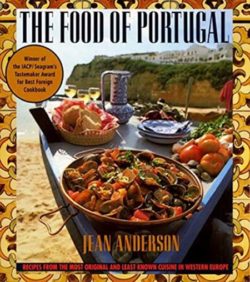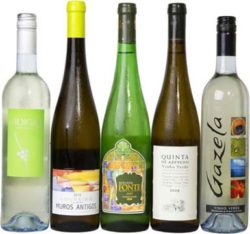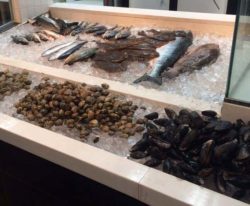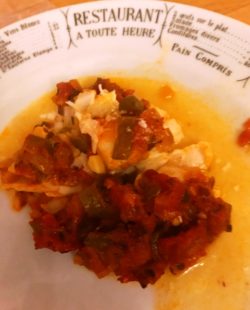Read Time: 3 Minutes Subscribe & Share
 Using A Cookbook To Plan A Trip
Using A Cookbook To Plan A Trip
Planning a trip? Wading your way through guide books, websites, articles, recommendations? Try reading a cookbook on the local cuisine. Before my recent trip to Portugal, I ordered a copy of Jean Anderson’s The Food of Portugal to try my hand at some delicious Portuguese food. Published in 1986, this book is much more than a cookbook. It is part travel-log, part guidebook with a great, easily reproducible map, a language guide and a thumbnail of Portuguese food history.
There is a chapter on The Language of Portuguese Food, Drink and Dining including a 32-page glossary, alphabetically arranged, of food words and phrases “to introduce the American to rudimentary kitchen and restaurant Portuguese, to attune the ear and focus the eye”. A chapter takes you through the wines of Portugal including how to read Portuguese wine labels. Ms. Anderson spent a large part of her life experiencing Portugal, its food, wine, custom and people. This book covers seashores, metropolitan cities, and mountain terrain from the Algarve’s southern most area to the Alto Douro in the north.
Check Out Elizabeth’s Trip
I traveled to Portugal in May. The two weeks were spent sampling enormous amounts of fresh fruit, tasting  delicious vinho verde, and eating fresh fish expertly and simply prepared. Hard to pick a favorite fish: plump, charcoal grilled sardines (sardinhas) drizzled in olive oil; baked hake (pescada), red mullet (salmonetes), big, black fish or scabbard fish (peixe espada) and bacalhau (salted cod) …. the signature fish of Portugal. It is said that there are as many different recipes for bacalhau as there are days of the year.
delicious vinho verde, and eating fresh fish expertly and simply prepared. Hard to pick a favorite fish: plump, charcoal grilled sardines (sardinhas) drizzled in olive oil; baked hake (pescada), red mullet (salmonetes), big, black fish or scabbard fish (peixe espada) and bacalhau (salted cod) …. the signature fish of Portugal. It is said that there are as many different recipes for bacalhau as there are days of the year.
My favorite was any fish simply grilled and slathered with fruity olive oil and simply seasoned. One variation was fish prepared with potatoes and vegetables in a tomato base and cooked in a “cataplana”. This hinged metal or copper container is shaped like a giant clam shell that is filled with the ingredients and clamped shut. The items steam-bake and all the flavors mix together producing a juicy sauce that is mopped up with chewy Portuguese bread. (note, I’ve used mine to cook chicken as well as fish…delicioso!)
Sources and A Portuguese Fish Recipe
 It is difficult to find a good fish market in the DC area, but our favorite one is Pescadeli which is owned by a Portuguese group (their butcher shop across the street is excellent too. It is home to several ingredients the Cuisinettes adored and stocked at the shop and on our website. Nunez de Prado Extra Virgin Olive Oil, Moulins Mahjoub salted capers, couscous, preserved lemons,Ortiz anchovies and their preserved tunas – all at good prices. Weep no more! Ask them for hake or cod to make this dish from Jean Anderson’s book. This is the season of tomatoes, peppers and onions that go into this recipe. Use a shallow ceramic casserole such as the porcelain ones by Pillivuyt or terra cotta helps to insulate the fish from the heat while the dish is baked.
It is difficult to find a good fish market in the DC area, but our favorite one is Pescadeli which is owned by a Portuguese group (their butcher shop across the street is excellent too. It is home to several ingredients the Cuisinettes adored and stocked at the shop and on our website. Nunez de Prado Extra Virgin Olive Oil, Moulins Mahjoub salted capers, couscous, preserved lemons,Ortiz anchovies and their preserved tunas – all at good prices. Weep no more! Ask them for hake or cod to make this dish from Jean Anderson’s book. This is the season of tomatoes, peppers and onions that go into this recipe. Use a shallow ceramic casserole such as the porcelain ones by Pillivuyt or terra cotta helps to insulate the fish from the heat while the dish is baked.


- 1 medium yellow onion, peeled and coarsley chopped
- 1 large garlic clove, peeled and minced
- 1 small sweet green pepper, cored, seeded and coarsely chopped
- 3 tbs olive oil for sauteing
- 2 tbs minced flat leaf parsley
- 4 juicily ripe tomatoes, peeled, cored, seeded and coarsely chopped
- 1/4 cup dry white wine
- pinch ground cloves
- 2 tbs tomato paste or finely chopped sun dried tomatoes
- 1 tsp fine sea salt
- 1/4 tsp freshly ground pepper
- 1.5-2lbs hake, cod, grouper, or haddock, cut into 1inch (2.2cm) slices.
- Saute the onion, garlic and green pepper in the olive oil in a large heavy skillet over moderate heat 5-6 minutes until limp.
- Add the bay leaves, parsley, tomatoes, wine, cloves, tomato paste, salt and pepper.
- Bring to a simmer, and maintain slow simmer when you cover the pan and cook 20 minutes.
- Uncover and cook longer if necessary to have this become the consistency of a thick pasta sauce.
- Preheat oven to 350F (170C) and generously butter a ceramic baking dish.
- Place fish slices close together in baking dish, making sure that the dish provides a close fit.
- Pour the tomato sauce over the pieces, cover and bake 15 minutes.
- Uncover and bake until fish flakes at the touch of a fork and this takes just a few minutes more.
- Some liquid develops in the baking of this dish. It depends on the fish chosen, whether it has been frozen or not. Pour off the liquid. Reduce and pour on top of the finished dish for an added kick of flavor.
- I always use a Pillivuyt or terracotta baker. Ceramic insulates the fish during cooking and the dish will have a much better texture.
Some Facts about Jean Anderson
To learn more about Jean Anderson, check out her website http://www.jeanandersoncooks.com or go to her Facebook Page. She describes herself as “cookbook author/editor, food and travel writer/photographer, food scientist/nutritionist, problem-solver (“Recipe Doc”), writing coach.” Many of you may be familiar with The Doubleday Cookbook (with Elaine Hanna) or The Grass Roots Cookbook showcasing American regional recipes. The Food of Portugal was named “Best Foreign Cookbook in the 1986 Tastemaker Awards.
I strongly encourage you to get a taste of Portugal with her book by exploring her easy-to-do Portuguese recipes. Perhaps they will inspire you to plan a trip as I did.
Elizabeth DiGregorio

Liz DiGregorio, newest Cuisinette, retired from a career in emergency management. She bought Julia Child’s Mastering the Art of French Cooking in 1967 and has been cooking ever since. Her love of Italian food is rooted in her DNA. When not re-arranging her cookbook library, she can be found in the garden, English mystery in hand and plotting her next escape from DC.




Comments are closed here.
Follow this link to create a Kitchen Detail account so that you can leave comments!